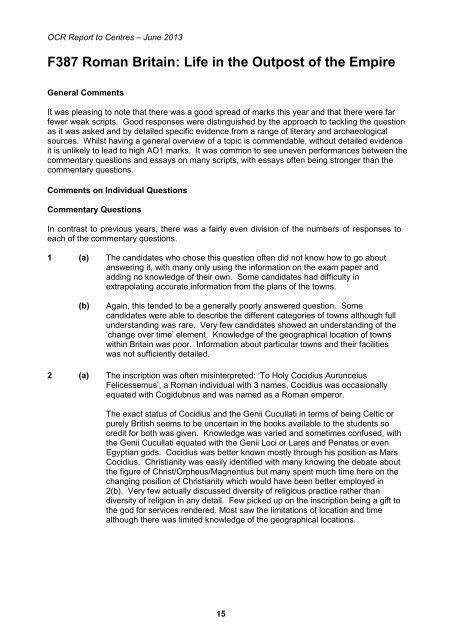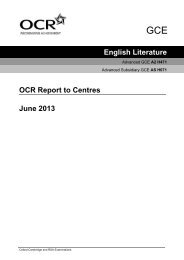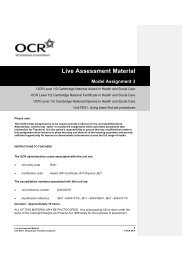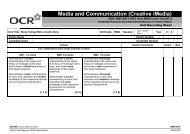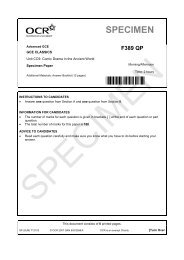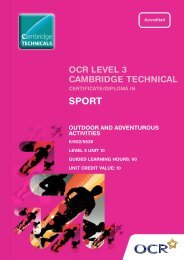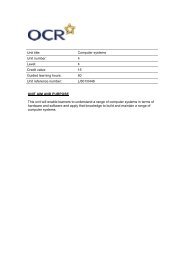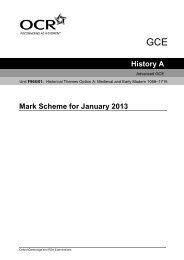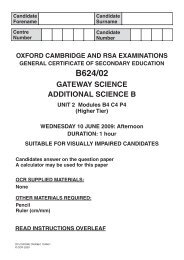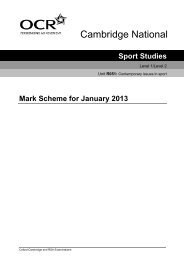Examiners' reports - June (PDF, 440KB) - OCR
Examiners' reports - June (PDF, 440KB) - OCR
Examiners' reports - June (PDF, 440KB) - OCR
Create successful ePaper yourself
Turn your PDF publications into a flip-book with our unique Google optimized e-Paper software.
<strong>OCR</strong> Report to Centres – <strong>June</strong> 2013<br />
F387 Roman Britain: Life in the Outpost of the Empire<br />
General Comments<br />
It was pleasing to note that there was a good spread of marks this year and that there were far<br />
fewer weak scripts. Good responses were distinguished by the approach to tackling the question<br />
as it was asked and by detailed specific evidence from a range of literary and archaeological<br />
sources. Whilst having a general overview of a topic is commendable, without detailed evidence<br />
it is unlikely to lead to high AO1 marks. It was common to see uneven performances between the<br />
commentary questions and essays on many scripts, with essays often being stronger than the<br />
commentary questions.<br />
Comments on Individual Questions<br />
Commentary Questions<br />
In contrast to previous years, there was a fairly even division of the numbers of responses to<br />
each of the commentary questions.<br />
1 (a) The candidates who chose this question often did not know how to go about<br />
answering it, with many only using the information on the exam paper and<br />
adding no knowledge of their own. Some candidates had difficulty in<br />
extrapolating accurate information from the plans of the towns.<br />
(b)<br />
Again, this tended to be a generally poorly answered question. Some<br />
candidates were able to describe the different categories of towns although full<br />
understanding was rare. Very few candidates showed an understanding of the<br />
‘change over time’ element. Knowledge of the geographical location of towns<br />
within Britain was poor. Information about particular towns and their facilities<br />
was not sufficiently detailed.<br />
2 (a) The inscription was often misinterpreted: ‘To Holy Cocidius Aurunceius<br />
Felicessemus’, a Roman individual with 3 names, Cocidius was occasionally<br />
equated with Cogidubnus and was named as a Roman emperor.<br />
The exact status of Cocidius and the Genii Cucullati in terms of being Celtic or<br />
purely British seems to be uncertain in the books available to the students so<br />
credit for both was given. Knowledge was varied and sometimes confused, with<br />
the Genii Cucullati equated with the Genii Loci or Lares and Penates or even<br />
Egyptian gods. Cocidius was better known mostly through his position as Mars<br />
Cocidius. Christianity was easily identified with many knowing the debate about<br />
the figure of Christ/Orpheus/Magnentius but many spent much time here on the<br />
changing position of Christianity which would have been better employed in<br />
2(b). Very few actually discussed diversity of religious practice rather than<br />
diversity of religion in any detail. Few picked up on the inscription being a gift to<br />
the god for services rendered. Most saw the limitations of location and time<br />
although there was limited knowledge of the geographical locations.<br />
15


